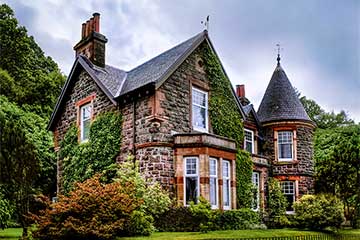Your address
Your address
The year your house was built
Tudor period (1485-1603)
- Typically constructed from timber and brick
- The upper floor often juts out over the ground floor
- Small glass windows
The year your house was built
Jacobean period (1604-1713)
- Flat-fronted, bare brick properties
- Steep, gabled roofs
- Hints of gothic style windows and doors
The year your house was built
Georgian period (1714-1820s)
- Tall, rectangular sash windows
- Symmetrical, central front door
- Large fireplaces that dominate rooms
The year your house was built
Victorian period (1830s-1890s)
- Well-built, coloured brickwork properties with sloping roofs
- Bay windows
- High ceilings
The year your house was built
Edwardian period (1900s-1910s)
- Broader than Victorian houses
- Hipped roofs with dormer windows
- Wide halls and dual-aspect rooms
The year your house was built
Post WW1 (1920s-1930s)
- Simplified design
- Bare brick or pebble-dashed
- Semi-detached family homes
- Large bay windows
The year your house was built
New Towns (1940s-1970s)
- Homes have uniform design
- Communal green spaces
- Equipped with indoor plumbing, central heating and electricity
The year your house was built
Postmodernism (1980s-1990s)
- Varied styles that mix old and new architectural elements
- Playful Forms: Some homes incorporate whimsical shapes and bold colours
The year your house was built
Eco Design (2000s-present)
- Use of reclaimed wood and low-impact composites
- Energy-efficient features like integrated solar panels and passive heating systems
Find out your exact home insurance cost
*Based on Experian data, November 2022. This is an estimate and may not be 100% accurate. If you're still unsure, check your mortgage valuation or Homebuyer Report.
We could not find any information for that postcode
Here are a few other ways you can find out when your house was built:
- Previous owners & neighbours
- Checking the property 'title register' or 'title deeds'
- Census data The National Archives
Once you know the age of your property - you can find out your exact home insurance cost
Sorry, we are having an issue at the moment, please try later
Here are a few other ways you can find out when your house was built:
- Previous owners & neighbours
- Checking the property 'title register' or 'title deeds'
- Census data The National Archives
Once you know the age of your property - you can find out your exact home insurance cost
I still can't find when my house was built
There are other ways you can find out when your home was built:
HM land registry
You can download a copy of a property's summary, title plan and title register. These documents will show you when your home was built along with other information.
Title register or title deeds
You will have been sent these documents after you completed the purchase of your home. A mortgage company or a conveyancing solicitor typically present these documents as proof of your ownership.
You can check the date of registration, this is when a plot of land is transferred from a property developer to a new owner.
Home survey
You may have paid for a house survey when you were buying your home. This should state when your home was built.
Mortgage offer
Your mortgage documents should outline various details about your home including the year it was built.
Contacting your local authority
Your local authority may possess records relating to your property such as when planning permission was granted.
Previous owners and neighbours
Check with previous owners of your property for information relating to when the home was built. If not you could ask your neighbours for help.
Listed building registers
If you're aware that the property is a listed building, an online search tool covering the UK can help you verify its age.






